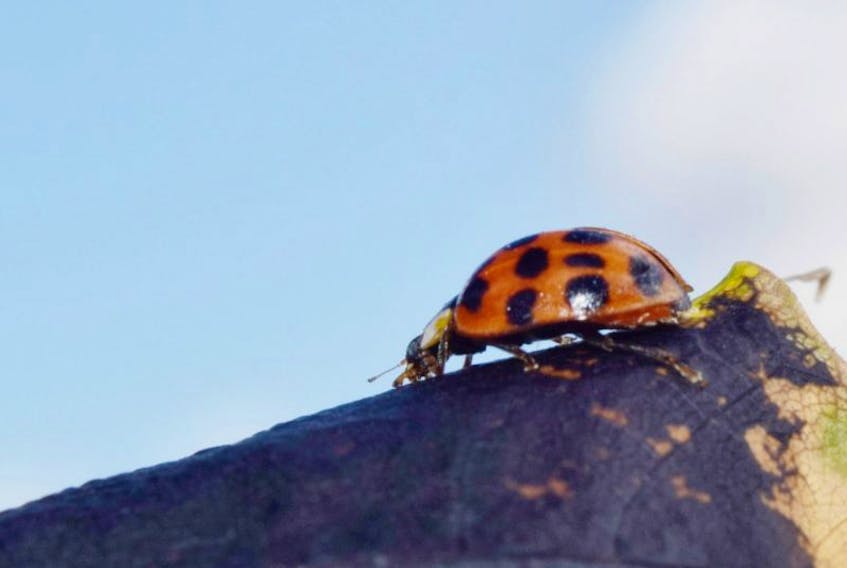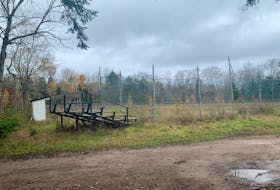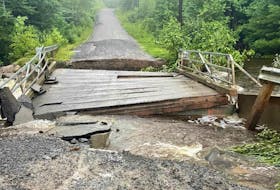Since the end of September, swarms of bugs known as the Asian harlequin ladybeetle have descended on the area. The Asian harlequin ladybeetle resembles the native ladybug with a more orange-like colour and slightly different colour patterns on its body.
Unfortunately, their appearance is where most of their similarities end.
The Asian harlequin ladybeetle has a habit of clustering in large numbers – and is known to bite. To the further frustration of many people in Pictou County, they produce a foul odour when crushed, so even disposing of them is a troublesome matter.
Colleen MacDonald, was visiting friends in Meiklefield when she had a particularly unpleasant encounter with a number of the bugs. While watching over a number of children outside, she ended up having a couple of them fly into her mouth, forcing her to immediately spit them out.
“There were a lot of them around – it was crazy,” said MacDonald. “I asked a few people about them, and some people saw them as far away as Salt Springs.”
John Klymko, a zoologist with the Atlantic Canada Conservation Data Centre said the Asian harlequin ladybeetle aggregates in large groups around buildings around the fall, seeking winter shelter – they eventually emerge from where they stow themselves away in the spring.
Klymko considers the beetles a problem because their appearance in the Maritimes, and other parts of Canada coincides with the decline and disappearance of native species of ladybeetle.
A similar dynamic took place, Klymko noted, when the transverse ladybeetle – a species native to the Maritimes – was supplanted by the seven-spotted ladybeetle. The transverse ladybeetle very quickly became a special concern species after the seven-spotted ladybeetle appeared.
“I think Pictou County is infested with these things,” wrote Marlene Davidson, a reader who commented on a Facebook post by the News that featured a picture of the beetles swarming the tire of a car. “They just seem to swarm you out of nowhere, once the heat of the sun hits them.”
“(I) couldn’t even go outside without letting half a dozen of them into the house,” wrote Linda Windsor.
Bob Parker, co-owner of West River Greenhouse, described himself as “no expert on them,” but recalled that the beetles showed up in Pictou County about a decade ago.
“I call them ladybug-lookalikes,” said Parker, who said the beetles were introduced in the Midwestern U.S. as a means of pest control.
Klymko said the Asian harlequin beetles can be seen as a problem by many, but actually are sometimes seen, from an agricultural perspective, as beneficial. That is because they eat the same pests as native ladybeetles: aphids.
“They’ve been intentionally introduced into North America, more than once, for aphid control,” Klymko said.
“They eat a lot of the pests on the crops, just like the ladybugs around here eat the aphids. They were introduced from somewhere in Asia,” said Parker.
Despite their aggravating behavior, the bugs pose no threat to anyone’s crops, so they are not classified as a pest – rather, as a nuisance.
“Pests eat crops, while a nuisance is something that causes you problems as an individual – like how they stink when you squish them,” said Parker. “They want in your house, and in every crack and crevice – they’ll cluster in corners around door and windows”
Parker said the best thing to do to prevent problems with the beetles is to prevent them from getting into houses and vehicles to begin with and making sure entrances are sealed tight, with caulking.
Klymko suggested using a vacuum to avoid crushing the insects – and patience.
“Get it as tight as you can, so they can’t crawl in,” Parker added. “They want in your house, and want every crack and crevice.”
WHAT YOU'RE SAYING:
A number of readers shared their perspectives on the Asian lady beetles clustering and swarming throughout Pictou County on Facebook.
Karen Kenny: “My house was full, on the front and side – hate them!”
Hector Campbell: “Yes, and I saw some green ones. That was a first for me.”
Nancy White: “Aren’t they supposed to eat other bugs?”
Bob Wilson: “They are attracted to anything that creates heat. They are trying to find a warm place to sleep for the winter, so watch around your doors when going in and out of the house – as well as the car and your clothes! I guess they bite as well, so beware!”









